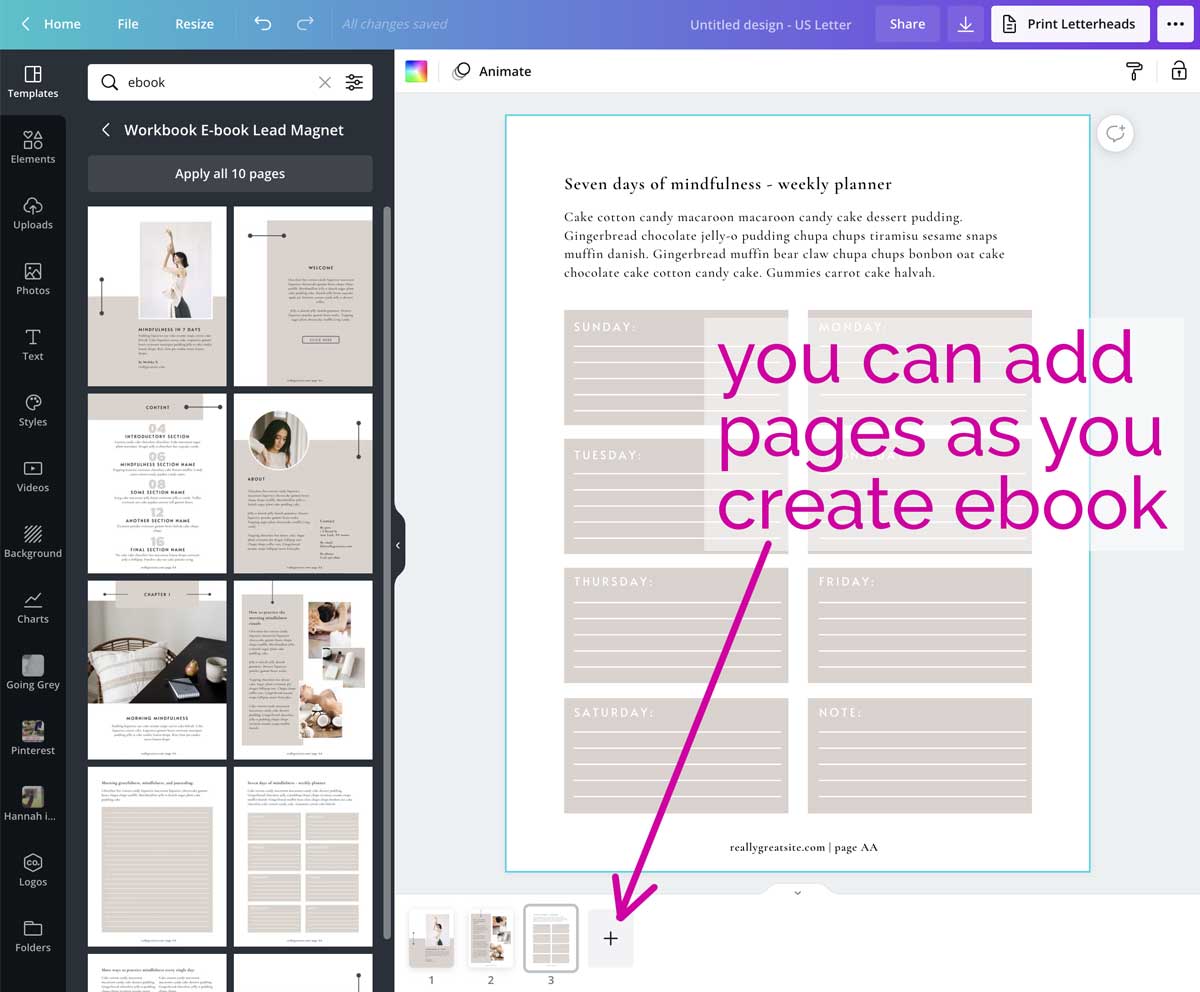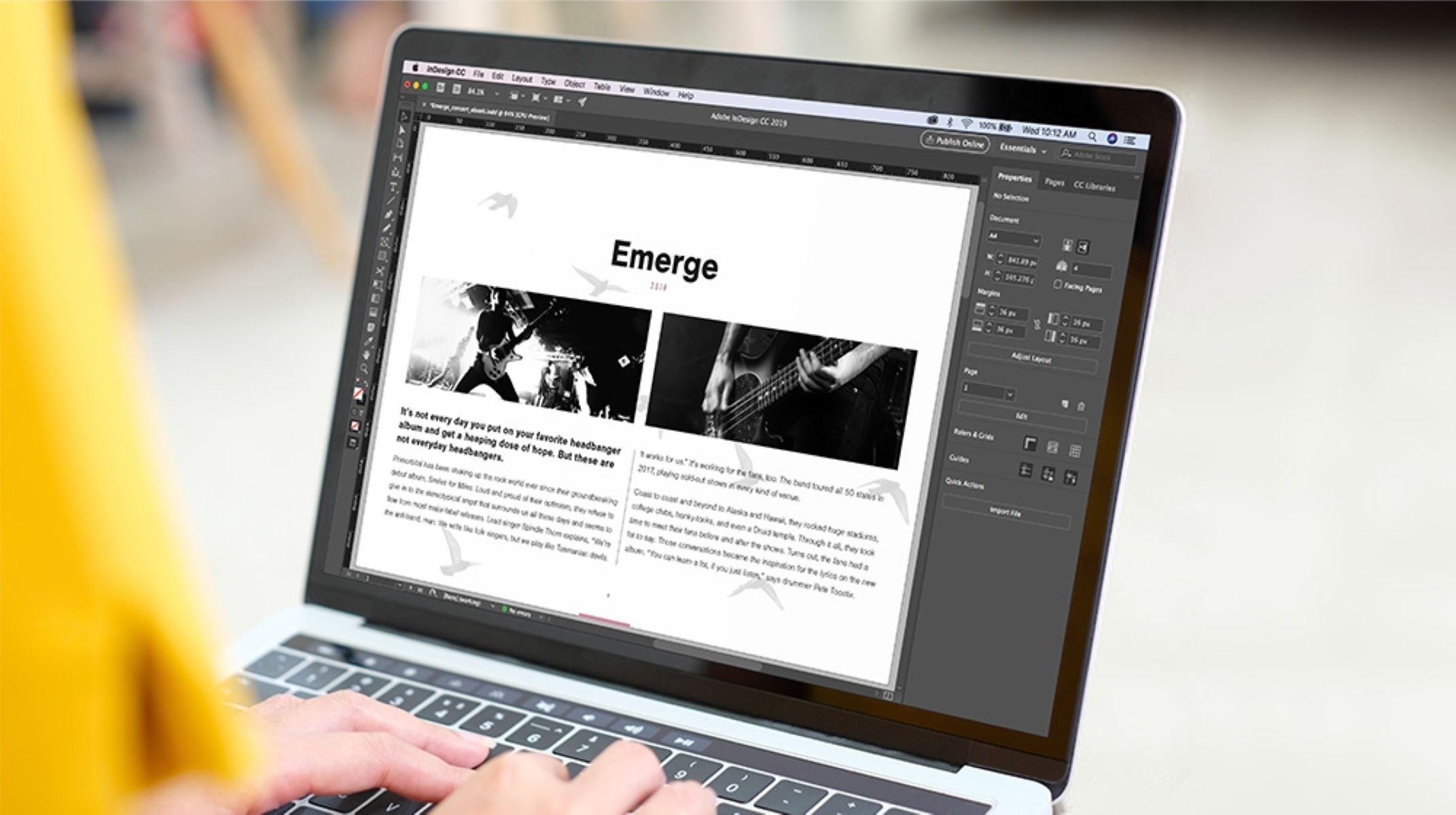Introduction
Welcome to the world of eBook creation! In today’s digital age, eBooks have become a popular and convenient way to share information, stories, and knowledge with a wide audience. Whether you are an aspiring author, a business owner looking to create a valuable resource, or simply someone with a passion for writing, creating an eBook can be a rewarding and fulfilling experience.
By self-publishing an eBook, you have the power to share your ideas and insights with readers all around the world. The possibilities are endless – you can write fiction or non-fiction, share your expertise on a specific topic, or even create a guide or tutorial. The freedom of eBook creation allows you to express your creativity and reach a global audience from the comfort of your own home.
In this comprehensive guide, we will walk you through the process of creating an eBook, from choosing a topic to publishing and marketing your masterpiece. Whether you are a seasoned writer or completely new to the world of writing, our step-by-step instructions and helpful tips will assist you in creating a professional and engaging eBook that readers will love.
Throughout this guide, we will cover various aspects of eBook creation, including researching your topic, outlining your eBook, writing and editing the content, designing the layout, formatting, and adding images and graphics. We will also delve into the important steps of creating a captivating cover, converting your eBook into different formats, publishing, and distributing it, as well as marketing strategies to ensure your eBook reaches its target audience.
So, if you are ready to embark on this exciting journey of eBook creation, let’s get started and turn your ideas into a beautifully crafted eBook that will captivate readers and leave a lasting impression!
Choosing a Topic
When embarking on the journey of creating an eBook, one of the first and most crucial steps is choosing a topic that will engage and resonate with your target audience. The topic you select will shape the direction and content of your eBook, so it’s important to consider a few key factors before making a decision.
Firstly, consider your interests and passions. Choose a topic that you are knowledgeable and passionate about, as this will make the writing process more enjoyable and ensure that you can provide valuable insights and information to your readers. Your enthusiasm for the subject will shine through in your writing and captivate your audience.
Next, think about your target audience. Who are you writing for? Consider the demographics, interests, and needs of your potential readers. Are you targeting a specific niche or a broader audience? Understanding your audience will help you tailor your content and ensure that it meets their expectations and addresses their interests and pain points.
It’s also essential to evaluate the market demand for your chosen topic. Is there a significant interest or demand for information on that subject? Conduct thorough research to identify if there is already an abundance of similar eBooks available. While competition is not necessarily a bad thing, it’s important to find a unique angle or perspective to differentiate your eBook and provide a fresh take on the topic.
Additionally, consider your expertise and credibility in relation to the topic. Are you an authority or have experience in the subject matter? Drawing from personal experiences or professional expertise will lend credibility to your eBook and give readers confidence in your insights and advice.
Lastly, take into account the longevity of the subject. Is the topic something that will remain relevant and valuable to readers over time? Choosing a timeless or evergreen topic ensures that your eBook will continue to be sought after and relevant, even as trends and interests evolve.
By considering these factors, you can select a topic for your eBook that aligns with your interests, meets the needs of your target audience, and has a strong market demand. Remember, choosing the right topic lays the foundation for a successful and impactful eBook.
Researching Your Topic
Once you have chosen a topic for your eBook, it’s time to dive into the researching process. Researching your topic is a critical step that will help you gather relevant information, gain a thorough understanding of the subject, and provide valuable insights to your readers.
Start by conducting comprehensive online research. Utilize search engines, online databases, academic journals, and reputable websites to gather information related to your topic. Take notes, bookmark helpful resources, and keep track of the sources you find. Ensure that the information you gather is accurate, up-to-date, and reliable. Cross-reference multiple sources to verify the credibility of the information.
In addition to online research, consider exploring offline resources. Visit libraries, bookstores, and archives to find books, magazines, and other printed materials that cover your topic. These resources often provide in-depth knowledge, unique perspectives, and valuable insights that you might not find online.
As you gather information, organize your research materials to make them easily accessible. Create digital folders or use note-taking applications to store and categorize your findings. This will make the writing process more efficient and help you refer back to the sources when needed.
During the research phase, it’s crucial to remain objective and consider different viewpoints. Examine both sides of controversial topics and present a well-rounded perspective in your eBook. This will add depth and credibility to your content and show readers that you have thoroughly explored the subject matter.
In addition to gathering information, engage with your target audience to understand their needs, questions, and pain points related to the topic. Join relevant online communities, forums, and social media groups to interact with potential readers and gain insights from their experiences. This will help you tailor your content to address their specific needs and concerns.
Remember, thorough research forms the foundation of an informative and valuable eBook. By dedicating time and effort to researching your topic, you can provide your readers with accurate, up-to-date, and insightful content that will keep them engaged and satisfied.
Outlining Your eBook
Before diving into the writing process, it’s essential to create a solid outline for your eBook. An outline serves as a roadmap, guiding you through the content creation process and ensuring a logical flow of information. It helps you organize your thoughts, structure your ideas, and maintain coherence throughout your eBook.
Start by brainstorming the main ideas and key points you want to cover in your eBook. Consider the goals and objectives of your eBook and break them down into subtopics or chapters. Each chapter should focus on a specific aspect of your topic, providing in-depth information and insights.
Arrange your ideas in a logical order. Think about the most effective sequence of topics that will engage readers and lead them through a smooth learning or storytelling experience. Create headers for each chapter and subheaders for specific subtopics within each chapter.
Within each subtopic, consider the supporting details and examples you want to include. These could be statistics, case studies, personal anecdotes, or quotes from experts. The supporting details help enrich your content and provide evidence for your claims or ideas.
As you outline your eBook, think about the overall structure and balance of the content. Consider the length of each chapter and aim for consistency throughout. You don’t want some chapters to be significantly longer or shorter than others, as this may disrupt the flow of your eBook.
Additionally, consider incorporating engaging elements such as exercises, checklists, or summaries at the end of each chapter. These interactive elements can enhance readers’ understanding, encourage application of the concepts learned, and provide a helpful recap of the chapter’s key points.
Remember, your outline is a flexible and living document. As you progress in the writing process, you may find the need to rearrange or modify your outline to better fit the flow of your content. Be open to making adjustments as necessary, ensuring that the final structure of your eBook is cohesive and easy to follow.
By taking the time to outline your eBook, you will save yourself from getting overwhelmed during the writing process. You’ll have a clear roadmap to follow and can focus on developing content that flows smoothly and resonates with your readers.
Writing Your eBook
With a solid outline in place, it’s time to bring your eBook to life through the writing process. Writing an eBook involves creating engaging and informative content that captivates your audience and delivers value. Here are some essential tips to help you with the writing process:
Start by setting a writing schedule and sticking to it. Consistency is key when it comes to completing your eBook. Create a realistic timeline and establish daily or weekly writing goals to stay on track.
Find a quiet and comfortable writing environment where you can focus and let your creativity flow. Eliminate distractions, whether it’s turning off your phone or closing unnecessary tabs on your computer.
As you write, consider your target audience and the tone you want to adopt. Are you writing in a formal, professional tone or a more conversational style? Tailor your language and writing style to resonate with your readers.
Write with clarity and simplicity. Use concise and straightforward language to convey your ideas effectively. Avoid jargon or complicated terminology, unless necessary for your target audience.
Break up your content into manageable sections or paragraphs. Use subheadings, bullet points, and numbered lists to enhance readability. This helps readers skim through your eBook and locate information easily.
Support your ideas with evidence and examples. Use data, research findings, or real-life case studies to back up your claims and provide credibility to your content. This helps readers trust and engage with your eBook.
Don’t worry about perfection during the writing process. Let the ideas flow freely and focus on getting your thoughts on paper. You can always go back later during the editing and proofreading phase to refine and polish your content.
Avoid excessive repetition and ensure a smooth transition between chapters and sections. Each chapter should build upon the previous ones, creating a cohesive and logical flow of information.
Remember to incorporate your unique voice and personality throughout your eBook. This helps connect with your readers on a personal level and makes the content more engaging and relatable.
Finally, stay motivated and enthusiastic throughout the writing process. If you find yourself facing writer’s block or a lack of inspiration, take breaks, seek feedback from others, or explore creative exercises to reignite your passion for writing.
By following these tips, you will be well on your way to writing a compelling and impactful eBook that resonates with your target audience and leaves a lasting impression.
Editing and Proofreading Your eBook
Once you have completed the initial draft of your eBook, it’s time to shift your focus to the editing and proofreading phase. Editing is a critical step that ensures your content is clear, coherent, and error-free. Here are some essential tips to help you effectively edit and proofread your eBook:
Take a break before starting the editing process. This allows you to approach your eBook with a fresh and objective perspective. Clear your mind and come back to it after a few days or weeks.
Read your eBook out loud. This helps you identify awkward sentence structures, grammatical errors, and areas where the flow of the content can be improved. Pay attention to the pacing and rhythm of your writing.
Check for consistency throughout your eBook. Review your usage of terminology, formatting, and style. Ensure that headings, subheadings, and bullet points are consistent in their formatting and structure.
Eliminate unnecessary or redundant content. Remove any repetitive information or sections that don’t contribute to the overall message or value of your eBook. Keep the content concise and focused.
Check for grammar, spelling, and punctuation errors. Use grammar and spelling tools, such as Grammarly or spell checkers, but don’t solely rely on them. Proofread manually to catch any errors that automated tools might miss.
Ask for feedback from others. Share your eBook with trusted friends, colleagues, or beta readers who can provide constructive criticism and identify areas for improvement. Consider their suggestions and make necessary revisions.
Ensure proper formatting. Pay attention to the alignment, font size, spacing, and overall visual appeal of your eBook. Make sure it is consistent and visually pleasing to read.
Check for factual accuracy. Verify any data, statistics, or references used in your eBook to ensure they are valid and up to date. This helps maintain the credibility of your content.
Proofread one final time before publishing. Even after multiple rounds of editing, it’s important to give your eBook a final once-over to catch any lingering errors or inconsistencies.
Consider hiring a professional editor. If you have the budget, hiring an editor can provide an invaluable fresh perspective and ensure a polished final product.
Remember, editing and proofreading are crucial steps in creating a professional and high-quality eBook. By taking the time to refine your content, you will enhance the readability and credibility of your work, leaving readers with a positive impression of your eBook.
Designing the Layout
Designing the layout of your eBook is an important step in creating a visually appealing and user-friendly reading experience for your audience. A well-designed layout not only enhances the overall aesthetic appeal of your eBook but also helps in organizing and presenting the content in a clear and accessible manner. Here are some key tips to consider when designing the layout of your eBook:
Choose a suitable font: Select a font that is easy to read on various devices and sizes. Avoid using decorative or complex fonts that may hinder readability. Opt for a clean and crisp font that complements your eBook’s style and genre.
Set appropriate font size: Ensure that the text is legible, especially for readers who may be viewing your eBook on smaller screens. Aim for a font size that is comfortable to read without straining the eyes.
Use appropriate formatting: Utilize formatting options such as bold, italics, and underline to emphasize key points or headings. This helps break up the text and make important information stand out.
Incorporate white space: Allow for sufficient white space in your layout to provide breathing room for the content. White space, or negative space, helps to reduce visual clutter and allows the reader’s focus to remain on the text.
Add visual elements: Enhance your eBook’s visual appeal by including relevant images, graphics, or illustrations. Visuals can help break up the text, illustrate concepts, and engage readers. Ensure that the visuals are of high quality and properly optimized for digital viewing.
Consider the use of color: Select a color scheme that aligns with your eBook’s theme or genre. Use colors consistently throughout the eBook to create a cohesive and visually pleasing experience. Be mindful of color contrast to ensure readability.
Structure your content: Organize your content into clearly defined sections with headings and subheadings. This helps readers navigate through the eBook and find specific information easily. Consider using numbered or bulleted lists for step-by-step instructions or key points.
Ensure mobile responsiveness: As more readers access eBooks on mobile devices, it’s crucial to design your layout to be mobile-responsive. Test your layout on various devices and screen sizes to ensure that the formatting and readability are maintained.
Consider accessibility: Make your eBook accessible to a wider audience by ensuring that it meets accessibility standards. Provide alternative text for images and ensure that the eBook is navigable using screen readers.
Preview and test your layout: Before publishing your eBook, preview it on different devices and formats to ensure that the layout appears as intended. Test the interactivity of any clickable elements such as hyperlinks or table of contents.
By paying attention to the layout design of your eBook, you can enhance the overall reading experience for your audience. A visually appealing and well-structured layout will captivate readers, improve comprehension, and make your eBook stand out from the crowd.
Formatting Your eBook
Formatting your eBook is a crucial step in creating a professional and polished final product. Proper formatting ensures that your eBook appears consistent, visually appealing, and readable across different devices and platforms. Here are some essential tips to consider when formatting your eBook:
Choose an appropriate file format: Select a file format that is widely compatible and ensures that your eBook can be accessed and viewed on various devices. The most common eBook formats are EPUB and MOBI.
Use consistent styling: Establish a consistent style for headings, subheadings, paragraphs, and other text elements throughout your eBook. This uniformity helps to create a cohesive and professional look.
Set margins and spacing: Determine appropriate margins and spacing to ensure readability. Sufficient whitespace around the text improves comprehension and gives your eBook a clean and organized appearance.
Consider the use of columns: Depending on your content and design, you may choose to divide your eBook’s pages into multiple columns. This can add visual interest and help optimize the use of space.
Ensure readability: In digital formats, it’s essential to optimize your eBook for readability. Use a legible font size, choose fonts with good screen rendering, and avoid excessive line lengths that may strain the reader’s eyes.
Format headings and subheadings: Make use of appropriate hierarchy in your headings and subheadings to create a logical structure. Use different font sizes, styles, or colors to differentiate between levels of headings.
Add hyperlinks: If your eBook includes references or external resources, add hyperlinks for easy navigation. Make sure the hyperlinks are clickable and properly formatted.
Include a table of contents: A table of contents allows readers to jump directly to specific sections of your eBook. Ensure that it is accurately linked to the corresponding chapters or headings.
Consider using page breaks: Insert page breaks at appropriate points in your eBook to separate chapters or sections. This helps create a more organized and reader-friendly experience.
Test your formatting: Preview and test your eBook on different devices and platforms to ensure that your formatting is preserved and appears as intended. Check for any formatting issues, such as text overlapping or misalignment.
Customize your eBook’s appearance: Depending on your publishing platform, you may have options to customize the appearance of your eBook, such as adding a cover image or adjusting the font, background color, or line spacing. Take advantage of these customization options to enhance the visual appeal of your eBook.
By investing time in formatting your eBook properly, you ensure that your content is presented in an organized and visually appealing manner. A well-formatted eBook enhances readability, professionalism, and overall reader satisfaction.
Adding Images and Graphics
Adding images and graphics to your eBook can greatly enhance the visual appeal, engagement, and overall reader experience. Well-placed visuals can complement your text, illustrate concepts, and evoke emotions. Here are some essential tips for effectively incorporating images and graphics into your eBook:
Choose relevant and high-quality visuals: Select images and graphics that are directly related to your eBook’s content and support the message you want to convey. Ensure that the visuals are of high resolution and clarity, as poor-quality images can negatively impact the overall presentation.
Consider copyright and usage rights: Use images and graphics that you have obtained the proper rights or licenses for, or utilize royalty-free or creative commons images that are available for commercial use. Always give credit to the original source if required.
Optimize image file sizes: Large image file sizes can lead to slow loading times and affect the reading experience. Compress your images without compromising on quality to ensure smooth loading on different devices and platforms.
Position images strategically: Place images close to relevant text or within the flow of the content to provide context and enhance understanding. This helps readers make connections between the visuals and the information being conveyed.
Use captions: Include descriptive captions for your images to provide additional information or context. Captions can help readers understand the significance of the image without having to rely solely on the surrounding text.
Create infographics or diagrams: Utilize charts, graphs, or visual representations to simplify complex information or data. Infographics and diagrams can help readers grasp concepts quickly and retain information more effectively.
Consider accessibility: Ensure that your eBook remains accessible to readers with visual impairments by providing alternative text (ALT text) for all images. ALT text describes the image to screen readers, allowing visually impaired readers to understand the visual content.
Test image placement and scaling: Preview and test your eBook on different devices and screen sizes to verify that your images are properly positioned and scaled. Check for any pixelation or distortion that may occur when an image is viewed on various platforms.
Create a visually balanced layout: Integrate images and graphics throughout your eBook in a visually appealing way. Avoid overcrowding or overwhelming the reader with too many visuals, but also ensure that the layout doesn’t feel too text-heavy. Strive for a balanced combination of text and visuals.
By thoughtfully incorporating images and graphics into your eBook, you can enhance its visual appeal and engagement. Visual elements help break up the text, make the content more dynamic, and reinforce key messages, making for a more captivating reading experience.
Creating a Cover
The cover of your eBook is like the front door to your content – it’s the first thing readers see and plays a crucial role in grabbing their attention and enticing them to explore further. A visually appealing and well-designed cover can significantly impact the success of your eBook. Here are some tips for creating an eye-catching cover:
Understand your target audience: Consider the demographics and preferences of your target readers. Research popular eBook covers in your genre or niche to get a sense of the design elements and styles that resonate with your intended audience.
Keep it simple and focused: Aim for a clean and uncluttered cover design. Avoid overcrowding with excessive text or imagery. Your cover should convey the main theme or idea of your eBook in a visually compelling and concise way.
Use striking visuals: Incorporate visually striking images or graphics that grab the reader’s attention and pique their interest. Choose visuals that align with the content of your eBook and create a sense of intrigue or curiosity.
Choose appropriate fonts: Select fonts that are legible and reflect the tone and genre of your eBook. Font styles should be complementary and readable on both small and large devices.
Create a focal point: Use design elements such as color, imagery, or typography to create a central focal point on your cover. This draws the reader’s attention and makes your eBook stand out from the crowd.
Add a compelling title: Use a captivating and descriptive title that accurately represents the content of your eBook. Experiment with different font sizes, styles, or colors to make the title visually appealing and easily readable.
Incorporate your author name: Include your name or pen name on the cover to establish author branding and recognition. Place it in a visible location, using appropriate font styles and sizes that match the overall design.
Consider the back cover: If your eBook will be available in print or as a physical copy, don’t forget to design the back cover. Include a brief author bio, a summary of the content, or testimonials to further entice potential readers.
Maintain consistency with your branding: If you have an existing author brand or a series of eBooks, ensure that the cover design aligns with your established branding elements, such as color schemes or font choices. This creates a sense of familiarity and continuity for your readers.
Get feedback: Share your cover design with trusted individuals or gather feedback from your target audience. Their input can help you refine and improve the design before finalizing it.
Use professional tools: If you don’t have graphic design skills, consider using professional design software or hiring a graphic designer to create a high-quality cover that meets your specifications.
Remember, the cover of your eBook is an important marketing tool that can attract potential readers and make a lasting impression. By investing time and effort into creating an appealing and visually captivating cover, you increase the chances of capturing the attention of your target audience and enticing them to explore your eBook further.
Converting Your eBook to Different Formats
Converting your eBook to different formats ensures that it can be accessed and enjoyed by a wider audience, regardless of their preferred reading devices or platforms. Converting your eBook allows you to reach readers who use e-readers, tablets, smartphones, or desktops. Here are some essential tips for effectively converting your eBook:
Choose a universal format: Select an eBook format that is widely compatible across various devices and platforms. The EPUB format is generally recommended as it is the industry-standard and can be read on most e-readers and devices.
Consider MOBI format for Kindle: If you plan to distribute your eBook on Amazon’s Kindle platform, converting it to MOBI format is necessary. Amazon’s Kindle Direct Publishing (KDP) accepts MOBI files for publishing on Kindle devices and apps.
Utilize eBook conversion software: There are numerous eBook conversion software programs available that can assist in converting your eBook to different formats. Well-known tools such as Calibre and Sigil offer user-friendly interfaces and support multiple formats.
Preserve formatting during conversion: Ensure that important formatting elements such as font styles, headings, images, and bullet points are preserved during the conversion process. Test the converted file on different devices to verify its integrity.
Test on multiple devices: After converting your eBook, test it on different e-readers, tablets, and smartphones to ensure that it appears as intended. Check for any formatting or layout issues and make necessary adjustments to improve the reading experience.
Validate your eBook: Once you have converted your eBook, it’s essential to validate it to ensure it meets industry standards. Utilize online validation tools or software to check for any errors that may impact the readability or functionality of your eBook.
Consider accessibility features: Ensure that your converted eBook maintains accessibility features such as adjustable font sizes, screen reader compatibility, and alternative text for images. This allows readers with visual impairments or disabilities to access and enjoy your content.
Review metadata and book details: Before distributing your converted eBook, review and update the metadata such as title, author name, description, and categories. These details are essential for proper indexing and discovery on eBook platforms.
Consider professional conversion services: If you’re not comfortable with the technical aspects of eBook conversion, consider hiring professional conversion services. These services can handle the conversion process for you, ensuring high-quality results and compatibility across devices.
Keep backups of your original files: It’s crucial to keep backups of your original eBook files before converting them. This allows you to make future edits or modifications if needed, without having to start from scratch.
By converting your eBook to different formats, you expand its accessibility and reach a wider audience. Ensuring compatibility across various devices and platforms increases the chances of successful distribution and engagement with your content.
Publishing and Distributing Your eBook
Once you have completed the creation and conversion of your eBook, it’s time to publish and distribute it to reach your target audience. Publishing and distributing your eBook allows you to make it available to readers all around the world. Here are some essential steps to successfully publish and distribute your eBook:
Choose your eBook platform: Consider the different eBook platforms available, such as Amazon Kindle Direct Publishing (KDP), Apple Books, Barnes & Noble Press, and Kobo Writing Life. Research their requirements, royalty rates, and features to determine which platform aligns best with your goals and target audience.
Create an account: Sign up for an account on your chosen eBook platform and follow their instructions for setting up your author profile. Provide all the necessary information, including your author bio, profile picture, and social media links.
Format your eBook: Ensure that your eBook is properly formatted according to the guidelines of your chosen publishing platform. Follow the instructions provided to format your eBook file and create a professional layout.
Upload your eBook: Follow the steps provided by the platform to upload your eBook file. Include all the required information such as the title, author name, book description, keywords, and categories. Upload your cover image and other relevant files as prompted.
Set the price and royalty options: Determine the price of your eBook based on factors such as the genre, market demand, and competition. Choose the royalty options provided by the platform, considering whether you want higher royalties with a lower price or lower royalties with a higher price.
Review and finalize: Review all the details and information you have provided before finalizing the publishing process. Check for any errors or missing information and make the necessary adjustments. Preview your eBook to confirm that everything appears as intended.
Choose distribution options: Consider whether you want to distribute your eBook exclusively through one platform (e.g., Amazon’s Kindle Select) or make it available on multiple platforms. Exclusivity can provide benefits such as eligibility for specific marketing programs, while distributing widely allows you to reach a broader audience.
Market your eBook: Once your eBook is published and available for purchase, it’s crucial to actively promote and market it. Utilize social media, your website or blog, email newsletters, and other promotional channels to generate awareness and exposure for your eBook.
Solicit reviews: Encourage readers to leave reviews and ratings for your eBook on the platform where it is published. Positive reviews can help boost your visibility and credibility, attracting more potential readers.
Track sales and performance: Regularly monitor your eBook’s sales and performance using the analytics provided by the platform. Analyze the data to gain insights into your audience, sales trends, and marketing strategies. Adjust your approach as needed to optimize your eBook’s success.
Consider additional distribution channels: Explore options for distributing your eBook through additional channels, such as aggregators or self-publishing platforms. These services can help you expand your reach and make your eBook available to a wider audience.
Remember, publishing and distributing your eBook is an exciting step towards reaching readers and sharing your story or knowledge. By following the necessary steps and employing effective marketing strategies, you can maximize your eBook’s visibility and connect with your target audience.
Marketing Your eBook
Marketing plays a vital role in increasing visibility, generating sales, and building a loyal reader base for your eBook. Effective marketing strategies help you reach your target audience, create buzz around your eBook, and maximize its potential success. Here are some essential tips for successfully marketing your eBook:
Define your target audience: Clearly identify the demographic, interests, and needs of your target audience. Understand their preferences, behaviors, and where they consume content. This knowledge will guide your marketing efforts and help you tailor your messages to resonate with your ideal readers.
Create a compelling author brand: Build a strong and consistent author brand across your website, social media profiles, and other platforms. Develop a unique voice and tone that align with your eBook’s genre and target audience. Your brand should reflect your values and attract readers with a consistent visual identity and messaging.
Optimize your eBook metadata: Research and select relevant and highly searched keywords to include in your eBook’s metadata, such as the title, book description, and categories. These keywords will improve the discoverability of your eBook in search results and increase its visibility.
Utilize social media: Leverage social media platforms to connect with readers and promote your eBook. Engage with your target audience by sharing relevant content, posting updates, hosting giveaways or contests, and participating in book-related discussions within your genre. Tailor your social media strategy to each platform and utilize hashtags to increase discoverability.
Build an author website or blog: Establish a professional website or blog to showcase your eBook and provide valuable content related to your niche or genre. Share insights, writing tips, or behind-the-scenes stories. Your website can serve as a central hub for readers to learn more about you and your work and can act as a platform for promoting your eBook.
Take advantage of email marketing: Build an email list of interested readers and regularly communicate with them through newsletters or email campaigns. Share updates about your eBook, exclusive content, discounts, or upcoming releases. Nurture your email subscribers with valuable content to cultivate their loyalty and engagement.
Request reviews: Approach reputable book bloggers, reviewers, or influencers in your genre and offer them a free copy of your eBook in exchange for an honest review. Positive reviews contribute to social proof and can drive more readers to discover and purchase your eBook.
Collaborate with other authors: Network with fellow authors within your genre and explore opportunities for cross-promotion. Guest blogging, participating in virtual author events or panels, or conducting joint giveaways can expand your reach and introduce potential readers to your eBook.
Offer limited-time promotions or discounts: Run promotional campaigns by temporarily reducing the price of your eBook or offering it for free. Promote these limited-time offers through social media, email newsletters, and relevant websites or forums to generate buzz and attract new readers.
Participate in online communities: Engage in online forums, book clubs, or social media groups where readers gather to discuss books in your genre. Offer valuable insights, engage in conversations, and avoid overtly promoting your eBook. Building genuine connections and establishing yourself as an authority in your genre can lead to organic recommendations and increased visibility.
Consider paid advertising: If your marketing budget allows, explore paid advertising options such as pay-per-click (PPC) ads or sponsored posts on social media platforms. Target your advertisements to reach your specific audience and track the ROI of your campaigns.
Monitor and adjust your marketing efforts: Regularly evaluate the effectiveness of your marketing strategies by analyzing sales data, engagement metrics, and feedback from readers. Continuously refine and adapt your marketing tactics based on the results to optimize your eBook’s visibility and sales potential.
Remember, effective marketing is essential for the success of your eBook. By implementing a well-rounded and targeted marketing plan, you can increase discoverability, engage with your audience, and drive more sales for your eBook.
Conclusion
Congratulations on completing your eBook creation journey! Throughout this guide, we have explored various aspects of creating, formatting, and promoting your eBook. From choosing a topic and conducting research to designing a captivating cover and marketing your eBook, each step plays a crucial role in the overall success of your project.
Remember to approach eBook creation with passion and dedication. Writing an eBook is not just about sharing information or storytelling; it’s about connecting with readers and making a lasting impact. Keep your target audience in mind throughout the process, ensuring that your content engages, educates, or entertains them.
Utilize the power of formatting and design to create a visually appealing eBook that is easy to consume. Pay attention to details such as font selection, white space utilization, and image placement to enhance readability and captivate your readers visually.
Don’t forget the importance of marketing in getting your eBook in front of the right audience. Develop a strong author brand, engage with readers on social media platforms, build an email list, and leverage collaborations and promotions to maximize your eBook’s reach and visibility.
Remember, the journey doesn’t end with the publication of your eBook. Keep track of sales, gather reader feedback, and continuously refine your marketing strategies. Adapt and evolve as you learn from your experiences to improve your future eBook projects.
Creating and publishing an eBook is a fulfilling and rewarding process. Embrace the opportunities that self-publishing offers, giving you the freedom to express your ideas and connect with readers all around the world in a digital format.
We hope this guide has provided you with valuable insights and guidance on your eBook creation journey. Now, it’s time to unleash your creativity, share your knowledge or story, and embark on a remarkable adventure as an eBook author. Best of luck!

























